Translate this page to any language by choosing a language in the box below.
If you'd rather watch a video about lab packs, click the image above.
Do you manage a warehouse, laboratory, hospital, school, college, biotech, pharmaceutical lab, research lab, medical facility, factory, or operation that uses small containers (usually less than 10 gallons each) of chemicals, solvents, reagents, paints, thinners, dyes, inks, acids, bases, cleaners, strippers, pool chemicals, dry cleaning compounds, etc.?
You probably have jars, boxes and containers of outdated, surplus and waste chemicals that are lab wastes and should be "lab packed". 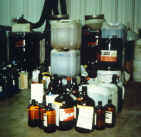
Over time, you will find that jars and cans have accumulated that are out-of-date, contaminated, partially used, leaking, or simply no longer needed. Some chemicals, like picric acid (commonly used in medical laboratories) become explosive as they age, and in a few months can explode just from the friction of opening the lid. Other chemicals, like solvents such as acetone, MEK, xylene, ether or toluene are hazardous wastes after you have used them. Chromic acid cleaning solutions, used or unused, are a hazardous waste. Old compressed gas lecture bottles can become very dangerous if the valves have rusted. Aerosol cans of paint, printed circuit board cleaners and degreasers are also hazardous wastes.
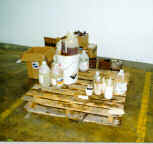
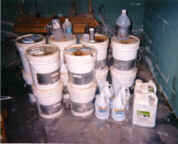
Waste chemicals in smaller containers are regulated under a variety of agencies: The EPA and RCRA ( Resource Conservation Recovery Act), U.S. Department of Transportation and OSHA all have regulations specific to the handling, packing, transportation and disposal of lab wastes and miscellaneous chemical wastes.
Academic labs are a subcategory with specific rules. The Environmental Protection Agency (EPA) issued the final Academic Laboratories Rule in 2008. This added a new subpart, 40 CFR Part 262 Subpart K, to the RCRA (the Resource Conservation and Recovery Act) for waste produced by or in academic (educational) labs. Subpart K requires school and university labs to:
What do you do with them? There are criminal penalties if you throw them out in the trash or pour them down a drain or outside. Yet, these many small quantities of dangerous chemicals can not safely be combined, and even if you could combine some without blowing yourself up, the resultant mixture is often more expensive to dispose in accordance with the 40 CFR Part 261 - 270 regulations. The EPA requires that transportation carriers be federally licensed and insured and that the disposal facilities that will receive the lab pack comply with TSDF standards. The DOT mandates that waste materials be packaged, labeled and shipped according to its regulations, which are especially complex for lab packs, due to compatibility and spill absorption requirements.
The proper method of disposal is to contract a specialist firm that knows the regulations and the chemistry to safely lab pack them for disposal at a RCRA-approved TSD facility.
Lab packing is the term used to describe the process of
This means segregating and separating the small containers according to their contents based on hazards, chemical composition and intended treatment or disposal method, all of which are defined by EPA, OSHA and DOT regulations. Our guide will walk you through this.
 2.
Repackaging and packing them into 55-gallon drums with compatible absorbent.
2.
Repackaging and packing them into 55-gallon drums with compatible absorbent.
Each drum will be shipped to a facility where it will be unpacked
for treatment and disposal, so obviously, each drum must contain
only containers whose contents are compatible, will not react with
each other and will go to the same intended treatment or disposal
method.
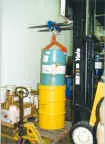 3.
Overpacks.
3.
Overpacks. Not every labpack contains small containers. A leaking 55-gallon drum may be "over-packed", packed inside a polyethylene-lined 85-gallon drum. See the photo at right of overpacking leaking or damaged 55-gallon drums:
This
step requires a methodical, careful approach to ensure that each
drum is labeled in accordance with DOT 49 CFR regulations.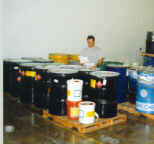
Upon completion, the lab pack company provides you with a complete and detail drum inventory and packing list and can arrange transportation and disposal as well. Lab decommissioning is one of the more complicated waste disposal operations as it is regulated in more detail by DOT, EPA and OSHA.
Far too often in the past, and sometimes even today, researchers simply dumped chemicals down the drain claiming "dilution would make it safe" . Of course, that is not true, as the wastewater entered a POTW and would kill the beneficial bacteria, accumulated in treatment sludges, leak into groundwaters, drink aquifers and even local lakes and rivers.
And don't think you won't get caught. Waters are tested far more than in the past, at many points in the system. Add to this disgruntled employees, student whistleblowers and surprise inspections conducted by federal or state agencies, all of which can happen at any time. MIT's Cambridge campus learned this in 1998 when the EPA conducted a surprise inspection and 56 of the 114 laboratories were in violation. MIT was cited for violations of RCRA, the Clean Water Act, and the Clean Air Act, totaling $150,000 in fines. You can see a list ofEPA's lab and academic inspections here.
Looking for company to do your lab packing for you? There are far fewer in business today than just a few years ago.
Click here for a current list of lab packing companies.
The following are pages related to lab packing which provide addition information:
Ways to save money AND help the environment:
Eat healthier AND save money: Instant Pot Duo Crisp 11-in-1 Air Fryer and Electric Pressure Cooker Combo with Multicooker Lids that Fries, Steams, Slow Cooks, Sautés, Dehydrates
Save water AND money with this showerhead adapter, it lets the water flow until the water is hot, then shuts off water flow until you restart it, ShowerStart TSV Hot Water Standby Adapter
Protect your health with these:
Mattress Dust mite-Bedbug protector, 100% Waterproof, Hypoallergenic, Zippered
Handheld Allergen Vacuum Cleaner with UV Sanitizing and Heating for Allergies and Pet, Kills Mite, Virus, Molds, True HEPA with Powerful Suction removes Hair, Dander, Pollen, Dust,
Immune Support Supplement with Quercetin, Vitamin C, Zinc, Vitamin D3
GermGuardian Air Purifier with UV-C Light and HEPA 13 Filter, Removes 99.97% of Pollutants
5 Stage Air Purifier, Features Ultraviolet Light (UVC), H13 True Hepa, Carbon, PCO, Smart Wifi, Auto Mode, Quiet, Removes 99.97% of Particles, Smoke, Mold, Pet Dander, Dust, Odors
Interesting Reads:
THE PREPPER'S CANNING & PRESERVING BIBLE: [13 in 1] Your Path to Food Self-Sufficiency. Canning, Dehydrating, Fermenting, Pickling & More, Plus The Food Preservation Calendar for a Sustainable Pantry
The Backyard Homestead: Produce all the food you need on just a quarter acre! Paperback
The Citizens' Guide to Geologic Hazards: A Guide to Understanding Geologic Hazards Including Asbestos, Radon, Swelling Soils, Earthquakes, Volcanoes
The Uninhabitable Earth: Life After Warming
Book: The Sixth Extinction: An Unnatural History Paperback